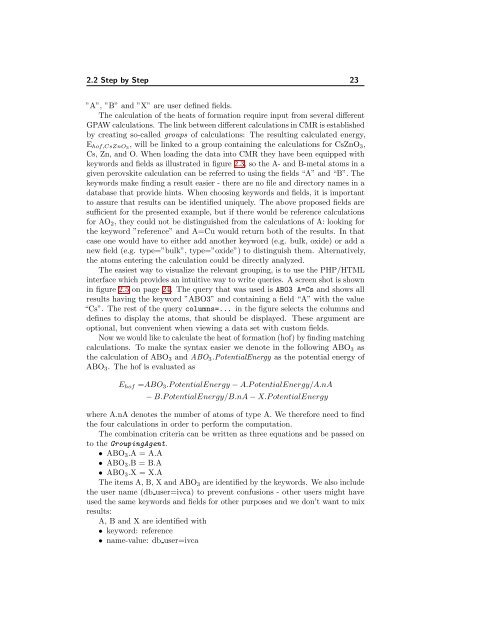The Computational Materials Repository
The Computational Materials Repository
The Computational Materials Repository
- No tags were found...
You also want an ePaper? Increase the reach of your titles
YUMPU automatically turns print PDFs into web optimized ePapers that Google loves.
2.2 Step by Step 23”A”, ”B” and ”X” are user defined fields.<strong>The</strong> calculation of the heats of formation require input from several differentGPAW calculations. <strong>The</strong> link between different calculations in CMR is establishedby creating so-called groups of calculations: <strong>The</strong> resulting calculated energy,E hof,CsZnO3 , will be linked to a group containing the calculations for CsZnO 3 ,Cs, Zn, and O. When loading the data into CMR they have been equipped withkeywords and fields as illustrated in figure 2.3, so the A- and B-metal atoms in agiven perovskite calculation can be referred to using the fields “A” and “B”. <strong>The</strong>keywords make finding a result easier - there are no file and directory names in adatabase that provide hints. When choosing keywords and fields, it is importantto assure that results can be identified uniquely. <strong>The</strong> above proposed fields aresufficient for the presented example, but if there would be reference calculationsfor AO 2 , they could not be distinguished from the calculations of A: looking forthe keyword ”reference” and A=Cu would return both of the results. In thatcase one would have to either add another keyword (e.g. bulk, oxide) or add anew field (e.g. type=”bulk”, type=”oxide”) to distinguish them. Alternatively,the atoms entering the calculation could be directly analyzed.<strong>The</strong> easiest way to visualize the relevant grouping, is to use the PHP/HTMLinterface which provides an intuitive way to write queries. A screen shot is shownin figure 2.5 on page 24. <strong>The</strong> query that was used is ABO3 A=Cs and shows allresults having the keyword ”ABO3” and containing a field “A” with the value“Cs”. <strong>The</strong> rest of the query columns=... in the figure selects the columns anddefines to display the atoms, that should be displayed. <strong>The</strong>se argument areoptional, but convenient when viewing a data set with custom fields.Now we would like to calculate the heat of formation (hof) by finding matchingcalculations. To make the syntax easier we denote in the following ABO 3 asthe calculation of ABO 3 and ABO 3 .PotentialEnergy as the potential energy ofABO 3 . <strong>The</strong> hof is evaluated asE hof =ABO 3 .P otentialEnergy − A.P otentialEnergy/A.nA− B.P otentialEnergy/B.nA − X.P otentialEnergywhere A.nA denotes the number of atoms of type A. We therefore need to findthe four calculations in order to perform the computation.<strong>The</strong> combination criteria can be written as three equations and be passed onto the GroupingAgent.• ABO 3 .A = A.A• ABO 3 .B = B.A• ABO 3 .X = X.A<strong>The</strong> items A, B, X and ABO 3 are identified by the keywords. We also includethe user name (db user=ivca) to prevent confusions - other users might haveused the same keywords and fields for other purposes and we don’t want to mixresults:A, B and X are identified with• keyword: reference• name-value: db user=ivca












